12
Jacqueline Aaron, Lauren Abraham, Gelila Hailemariam, Sophie Loree, and Jackson Lundberg
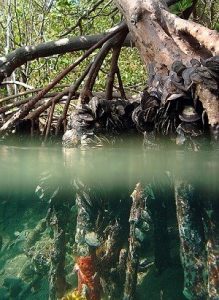
A View of a Mangrove Ecosystem. Photo by Caroline Rogers, National Park Service, Public Domain.
The Aqua-Terrestrial Life of the Mangroves
Mangroves are plants that thrive in salty coastal marine habitats. In the United States, mangrove shrubs and trees can range from 6.5 feet (2 meters) to 33 feet (10 meters) in height with oval-shaped leaves (Conservation International 2020). Mangrove species can produce flowers that are yellow, white, green, or red (Selvam 2007). In the tropics, red mangroves can grow to 80 feet (24 meters; NWF 2020). Mangroves can grow bigger in the tropics due to more water and sunlight. Salt from the seawater is excreted in different methods depending on the species of mangrove; it may be excreted through the glands in the leaves, the root system, or the bark on the roots (AMNH 2020). The leaves also function to retain water within the plant. They have a waxy coating to capture water and have small hairs which are used to reduce water loss during photosynthesis. However, out of all the tree’s characteristics, its unique root system sets mangrove tree species apart from tree species around the world. The exposed arched root system either projects out from the trunk like stilts or extends in wide and curved plank-like formations. The roots act to stabilize the mangrove shrub or tree’s shallow root system within the soil and sediment. The exposed root system also functions as the conduit for oxygen for respiration. Thousands of raised pores called lenticels on the exposed roots (also known as pneumatophores) allow for oxygen intake and then close during high tide (AMNH 2020). The method by which mangroves reproduce is just as fascinating as to how mangroves take in oxygen.
A mangrove reproduces by producing small flowers in late winter or early spring. The flowers produce a bud, or propagule, which then has a further growth period. The propagule then splits off from the parent plant and is sent into the water for further embryonic development. The amount of time that the propagule will float in the water depends on the species; embryonic development for the red mangrove is up to 40 days, for the black mangrove it is up to 14 days, and at least 5 days for the white mangrove (Booker et al. 1998). Once the propagule becomes waterlogged, it sinks to the bottom of the water, germinates into the mud and sediment, and grows plant roots and leaves, a process varying between 5 -15 days. The new mangrove plants produce propagules of their own, and the life cycle continues (NHMI 2021). Another adaptation mangrove shrubs and trees have developed is being able to store carbon from the atmosphere in the soil (MOW 2020). The process starts as carbon is taken in from carbon dioxide for the development of a mangrove’s leaves, branches, and roots. Carbon is captured in the leaves and when dead leaves settle in the mud and sediment, the carbon is stored in the soil. This organic matter is called “blue carbon” because it is fixed in ocean ecosystems (MOW 2020). These unique methods of sprouting new growth and storing carbon dioxide explain how mangrove forests have been able to grow along coastlines all over the world.
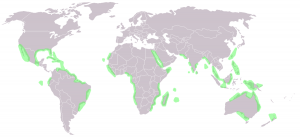 Figure 1: The map shows the global distribution of mangroves. “World map mangrove distribution.png” by Pinpin, CC BY-SA 2.5
Figure 1: The map shows the global distribution of mangroves. “World map mangrove distribution.png” by Pinpin, CC BY-SA 2.5
As of 2010, mangroves covered an estimated 137,760 square kilometers (53,190 square miles) of the Earth’s surface (Figure 1). Mangrove forests are found in over 118 countries, however, almost 75% of mangrove forests are in only 15 countries (NASA Earth Observatory 2010). As shown in Figure 2, the top 5 countries with the most area of mangrove forests are Indonesia, Brazil, Malaysia, Papua New Guinea, and Australia (Hamilton and Casey 2016). Mangroves are usually located around the equator between 25° North and South latitude covering five continents, mangrove forests are located as follows: 42% in Asia, 21 % in Africa, 15 % in North and Central America, 12 % in Australia, and 11 % percent in South America (NASA Earth Observatory 2010). Due to their wide distribution, as shown in Figure 1, mangroves provide a variety of economic and ecological benefits for coastal communities around the world.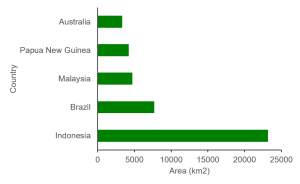 Figure 2: Top 5 countries with the most area of mangrove forest. Graph is drawn with 2014 data from Hamilton and Casey (2016), CC BY 4.0
Figure 2: Top 5 countries with the most area of mangrove forest. Graph is drawn with 2014 data from Hamilton and Casey (2016), CC BY 4.0
The Economic and Ecological Importance of Mangroves
The global estimate for all the ecosystem services mangrove forests provide (coastal protection, carbon sequestration, harvestable wood, tourism, and fisheries) comes to a total of $25 trillion USD (zu Ermgassen et al. 2021). The global mapping of carbon sequestration (the process of capturing and storing carbon dioxide) is shown in Figure 3. The greatest impact of mangrove forests on human communities is observed in near-shore fishing communities in less developed countries, where they help to support the economies and food security of these high poverty areas (zu Ermgassen et al. 2021). For local communities around mangrove forests, mangroves provide valuable wood to build houses because the wood is insect and rot resistant and they provide fish populations as a food source. Mangrove forests can also be used as “nursery habitats for (commercially important) crab, prawn and fish species, and support offshore fish populations and fisheries” (Nagelkerken et al. 2008).
Data collected from the French overseas territories was used to calculate the annual service of water purification to be about 109 million euros/year, which would be about 130 million USD/year (Trégarot et al. 2021). Other service sums include coastal protection, which was between 202 million and 688 million euros/year, carbon sequestration was about 938 million euros/year, and supporting fish biomass production summed up to about 88 million euros/year (Trégarot et al. 2021). Mangroves cover only 0.1% of Earth’s land surface and store more carbon per hectare than any other type of forest (Marcus 2018) and occupy one-quarter of the tropical coastline on Earth (Acharya 2002).
Mangroves and fish populations are so intertwined that the loss of one square mile of mangrove forest will cause a loss of about 124 metric tons of fish per year (Feller 2018). The aerial roots help create habitats for sponges, meiofauna, macrofauna, prawns, insects, elasmobranchs, bony fish, as well as amphibians, reptiles, and birds (Nagelkerken 2008). Even microorganisms rely on the mangrove’s roots and in turn provide for their ecosystem by filtering out nitrates and phosphates from rivers and streams before reaching the sea (AMNH 2019). Mangrove forests also provide a canopy for other non-aquatic species such as birds, insects, mammals, and reptiles (Nagelkerken et al. 2008). Due to the dependence of many organisms on mangrove forests in coastal ecosystems, mangroves are considered a keystone species and are vital to the biodiversity of coastal ecosystems (AMNH 2019).
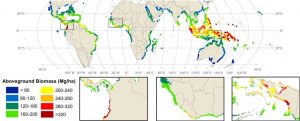
Figure 3: A global map showing the global distribution of carbon stored in mangrove forests. “Figure 2. Global mangrove map showing modeled patterns of above-ground biomass per unit area.” by Hutchinson et al. 2013, CC BY-NC-ND 3.0
One of the most important aspects of how mangrove forests contain such biodiversity is through the leaves of the mangrove. When the leaves of a mangrove tree fall, they fall to the floor where they are broken down and decomposed to form detritus. This process cycles nutrients back into the ecosystem where microorganisms such as algae and plankton are able to prosper, creating food for the rest of the food web. Many organisms such as crabs, small fish, and prawns eat the decaying detritus directly. This combination of nutrient-rich detritus and the complex root structure of the mangrove trees provides an ideal habitat for many aquatic organisms. These organisms then become food for the top consumers in the ecosystem- crocodiles, sharks, ospreys, and humans (Shaw 2013).
The marine life that thrives in these estuarine ecosystems supports the needs of residents in the surrounding areas. With around 4.1 million fisheries associated with mangrove forests worldwide, the effects of climate change on mangrove habitats permeate far beyond the devastating ecological impact (zu Ermgassen et al. 2021). As mentioned previously, the coastal communities that rely on food and other resources from these mangrove forests have been forced to adapt their lifestyles to the changing mangrove ecosystems. Mangroves prevent erosion, provide coastal and wind protection, and help with water purification (Trégarot et al. 2021). These ecosystem services are vital to the survival of coastal communities, putting them at risk as mangroves continue to be affected by climate change, pollution, and coastal/urban development and, for some, being on the brink of extinction.
The Loss of Mangroves
There are 70 known species of mangroves, 11 of which are at a higher risk of extinction (Polidoro et al. 2010). Based on data from IUCN the two mangrove species Sonneratia griffithii and Bruguiera hainesii are critically endangered. The species Camptostemon philippinense, Heritiera fomes, and Heritiera globosa are endangered. Heritiera globosa, a rare species with less than 250 known adult trees, and Sonneratia griffithii, which lost 80% of the population over the past 60 years, have the largest global loss percentage (Polidoro et al. 2010). The red mangrove species is not threatened, but the overall population is declining (Ellison et al. 2015). It is difficult to determine the number of individual Rhizophora mangle trees in the world as they grow in large tangles, often with other species of mangrove trees. However, according to a 2011 study, there are about 55,000 km2 of mangrove forests that are found within Rhizophora mangle’s native range (Giri et al. 2011). Although it is difficult to estimate the number of individuals of mangrove trees, there is an observed downward trend in population numbers.
Fifty percent of the world’s mangroves have disappeared in the past half-century, due to two major factors. The first is due to very low genetic variability between mangroves which are almost identical to their neighbors. Without genetic diversity, species are not able to adapt to a change in their environment, increasing the probability of populations with similar genetics becoming extinct. The lack of genetic variability indicates a past change in sea level, caused by a retreat of the glaciers, that killed most of the mangrove population causing a genetic drift (Candy 2018). After this occurrence, the mangrove species had less genetic variation.
The second major factor of the mangrove population decrease is the human environmental impact. The populations of all mangroves have decreased due to agriculture, coastal development, low rates of reproduction, pollution, and climate change (ELAW 2021). Mangroves are removed to make space for “artificial ponds that are densely stocked with shrimp” (AMNH 2020). The chemical soup, containing copper and organic tin compounds, must be poured into the water supply to keep the shrimp alive. This contaminates the seawater by creating toxic residues and sediments, and the mangroves are essentially poisoned (Gräslund and Bengtsson 2001). Mangrove forests are removed for other agriculture such as rice paddies, rubber trees, and palm oil plantations that replace the coastal areas. The extensive exploitation of mangrove forests may lead to the potential loss of these species. Government actions to enforce management practices and protection of mangroves are needed to discontinue the downward population trend.
Conservation efforts and Mangrove Management Practices
As mangrove populations decrease, with some being critically endangered, it is important to make conservation efforts to help save the populations. Data collected in the French overseas territories estimates that 70.6 % of the mangroves in the area are legally protected but only 25.5% of those mangroves are effectively managed (Trégarot et al. 2021). On a global scale, efforts are being made by conservation groups such as the World Wildlife Foundation (WWF). One conservation project established by WWF for mangroves includes Tun Mustapha Park, the largest marine protected area in Malaysia, which encompasses more than 2.2 million acres of coral reefs, mangroves, seagrasses, and productive fishing grounds (Marcus 2018). Another protected area established by WWF and local communities is Sanquianga National Park in Colombia. The park consists of a 197,000-acre protected area that includes 105,700 acres of mangroves and is a crucial source of income for more than 125 communities along Colombia’s Pacific coast (Marcus 2018). Both of these examples, National park reserves and the fact that they both support local communities economically, is a prime example of agroforestry, which is the land management method of integrating forests with crops and pasture land in order to protect the ecosystem diversity and nutrients of the soil (Gold 2017). If the mangroves were removed, there would be space for greater nearshore fishing endeavors, but since fish populations rely on the mangroves the benefit is greater to conserve mangrove forest populations, resulting in greater fish populations and diversity. A global issue is that mangrove forests have been cleared and now need the contributions of conservation organizations and government aid.
With the appropriate government aid in place, mangrove forests can recover. An example of this is seen in Singapore. Singapore has lost more than 90% of its mangrove forest extent since becoming an independent state in 1965 as land has been reclaimed for industrial development and aquaculture, freshwater reservoirs have been constructed in previously mangrove-fringed estuaries, and the shoreline has eroded and been increasingly polluted. In 2018, there were only 0.81 km2 of mangrove coverage in Singapore (Ellison et al. 2020). Mangrove rehabilitation efforts in Singapore started because the government made climate change and preparing the country for rising sea levels a key priority. The Singaporean government has included programs like ecological engineering, monoculture plantations, and Ecological Mangrove Restoration (EMR) approaches (Ellison et al. 2020).
Ecological engineering was used on Pulau Tekong, an island off Singapore’s northeast coast, where mangrove saplings have been planted within new and existing hard coastal defense structures due to the coastline being severely damaged from shoreline erosion (Ellison et al. 2020). The mangrove population increases on the coast and it is considered ecological engineering because nature is being used to help the human population by preventing erosion.
Monoculture plantations were used on Pulau Semakau to plant 1,900 propagules (segments of mangrove trees) per hectare to replace the loss of habitat from clearing the original forest to make way for a landfill (Ellison et al. 2020). Monocultures are typically regarded as bad for the environment, but because this monoculture was made up of multiple species of mangroves, it helped the biodiversity in the area. This density was required to account for the ≈ 94% mortality rate of the planted propagules that is common with monoculture rehabilitation projects globally (Ellison et al. 2020). Despite the high possible mortality rate, the monoculture was created to combat the large loss of habitat from creating the landfill. The high mortality rate of monocultures typically comes from nutrient competition, a farm of many different plants would require many different nutrients, so competition is low. In a monoculture of mangroves, all of the trees are competing for the same nutrients.
One of the first EMR approaches in Singapore was observed in Pasir Ris, and was designed to allow mangrove seedlings to naturally colonize a 1-ha area that had been reclaimed previously. The goal was to create corridors between other mangrove patches along the coastline of Pasir Ris (Ellison et al. 2020).
A second, and most recent, EMR project was the recolonization of the abandoned agricultural ponds on Pulau Ubin. The community-based rehabilitation effort in the 8.8 ha area required extensive mapping of the local mangroves and examination of the biophysical conditions in the area. The purpose was to match the conditions for successful mangrove growth with the new mangrove species that were planted during the EMR project (Ellison et al. 2020). After 20 years, more mangrove species had grown than what was originally planted, mollusks, crustacea, and snakes had established in the area, and a higher amount of fish diversity has been observed compared to areas with constructed shorelines (Ellison et al. 2020).
The success of these three methods shows the importance of recreating the correct biophysical conditions for seedlings, offering artificial protection for seedlings, planting numerous species of mangroves, planting enough to overcome the high seedling mortality rate, and increasing the area of mangrove rehabilitation in order to restore mangrove forests in urbanized coastal settings (Ellison et al. 2020). By following the methods used by Singapore, coastal cities around the world would be able to drastically increase the populations of mangrove forests. Despite the enormous number of benefits mangrove forests provide, there is an overall decline in the populations of Mangrove tree species and conservation organizations are stepping up.
As climate change continues to alter coastal ecosystems, overall mangrove conservation efforts have become more widespread, as shown in Figure 4. The Global Mangrove Alliance (GMA) is a community of activists and scientists who are committed to “comprehensive mangrove conservation and landscape restoration that help the world mitigate and adapt to climate change, safeguard biodiversity, and enhance the well-being of the most vulnerable coastal people” (Knowledge Hub 2018).
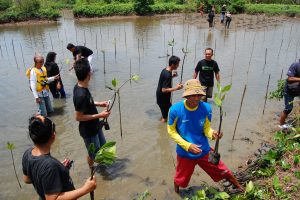
Figure 4: A group of individuals in Jakarta, Indonesia planting mangrove propagules. “Planting mangrove” by Ikhlasul Amal, CC BY-NC 2.0
The GMA has many current conservation initiatives including one in the Philippines to sponsor community activism and engagement in local ecosystems. The World Wildlife Foundation (WWF) works with the GMA and together they work to conserve mangroves in Malaysia. Tun Mustapha Park, the largest marine protected area in Malaysia, was founded with community help and encompasses more than 2.2 million acres of coral reefs, mangroves, seagrasses, and productive fishing grounds. The park allows for agroforestry to occur because of the positive relationship mangroves have with fish populations and in turn the fishing industry of local communities (Marcus 2018). As a result of these management practices, the rate of mangrove decline has stabilized. In the late 20th century, the mangrove rate of decline was 1% to 3% per year (Lo 2020). As of September 2020, the rate of decline has ameliorated from 0.3% to 0.6% (Lo 2020). This statistic shows the hard work that has been poured into mangrove conservation, but also shows that there is still a great amount of work to be done in terms of conservation. Mangrove conservation and management are very different across the varying regions where mangrove forests grow leading to differing rates of habitat loss by region.
Case Study: Florida’s Fight for Mangrove Preservation
In looking at mangrove protecting policies in Florida, it is important to first understand the history of mangrove populations in the region and how urbanization has affected these populations. Tampa Bay, located on Florida’s southwest coast, is one of the ten largest coastal ports in the nation. Over the past 100 years, this part of the state has seen a rapid influx in population and subsequent urbanization. As a result of new development since the 1920s, “Tampa Bay has lost over 44 percent of its coastal wetlands acreage; this includes both mangroves and salt marshes” (FDEP 2021). This loss in mangrove habitats has resulted in an overall loss in biodiversity and the decay of the local estuarine ecosystem.
Similar effects on mangrove populations are evident elsewhere in the state. On Florida’s southeast coast is a lake known as Lake Worth that naturally evolved from a saltwater lagoon to a freshwater lake. It has since been changed back to an estuarine lagoon as the result of human modification. Due to these changes, Lake Worth has seen an 87% decrease in the overall mangrove acreage over the past 40 years (FDEP 2021). What used to be vast mangrove forests have been replaced with invasive Australian pines as they are more desirable in the newly developed suburban neighborhoods. In this area of Lake Worth, the 276 remaining acres of mangrove forests are strictly protected by state regulation.
To combat the rapid loss of mangrove ecosystems, regulations have been put in place and enforced to ensure the survival of these vital native estuarine species. In 1996, the Mangrove Trimming and Preservation Act was enacted with the intent to “protect and preserve mangrove resources valuable to our environment and economy from unregulated removal, defoliation, and destruction”(FDEP 2021). This act outlines exactly how mangrove populations can be altered by private citizens in the state of Florida. The main points focus on ensuring that professional mangrove trimmers and certified arborists are the sole persons trimming and altering mangrove forests of a specific size. On private property, “trimming must be conducted in stages so that no more than 25 percent of the foliage is removed annually” (FDEP 2021). This is to ensure the longevity of localized mangrove populations. It is also stated that there can be no use of chemicals or herbicides to remove leaves from a mangrove tree (FDEP 2021).
Despite the enactment of this policy in 1996, the population of mangroves has continued to decrease in Florida. This is largely due to the continued coastal development and overall urbanization of the state. With the imminent threat of more species loss, further legislation and personal action are necessary to protect these keystone species. Mangroves contribute immensely to both aquatic and inland ecosystems and with their continued depletion comes a great risk for these environments. Governmental-mandated management practices have proven minimally effective as states often prioritize development for monetary gain over the environmental needs of the local ecosystems. For this reason, it is necessary that individual action must be taken to help protect mangrove species.
What Can You Do To Help the Mangroves?
In regions where mangroves present are in forests, many environmental groups work to protect these vital natural resources. These groups and nongovernmental agencies are always looking for funding and volunteers to aid in the fight to defend mangrove populations. Efforts can also be made to protect mangrove ecosystems by those who do not live near these keystone species. People can choose to stay away from vacation spots built on mangrove forests as tourism has led to the destruction of mangrove forests. These forests have been removed to expand land development in tropical locations. Mangrove forests are also being destroyed to make room for agriculture such as seafood, palm oil, rice, and rubber. One way to contribute to helping mangrove forests is by refraining from purchasing any seafood or other products that use palm oil, rice, or rubber that was grown in a former mangrove forest. Limiting personal waste and production helps reduce pollutants that threaten the livelihood of mangrove forests.
Summary
Mangroves are the cornerstone of life for coastal ecosystems and communities. Found in over 118 countries located near the equator, mangroves serve as ecological and economic giants for the estuarine and human communities that they serve. The greatest impact of mangrove forests on human communities is observed in near-shore fishing communities in less developed countries, where they help to support the economies and food security of these high-poverty areas. Mangroves are the most carbon absorbent forests on earth and provide many ecosystem services including the prevention of erosion, coastal wind protection, and water purification. Mangroves are the roots of estuarine ecosystems and must be protected to ensure future coastal prosperity.
Citations
Acharya G. 2002. Life at the margins: The social, economic and ecological importance of mangroves. Madera y Bosques, 8, 53–60. https://doi.org/10.21829/myb.2002.801291
AMNH (American Museum of Natural History). 2019. Why mangroves matter. American Museum of Natural History [accessed 2021 Mar 15]. https://www.amnh.org/explore/videos/biodiversity/mangroves-the-roots-of-the-sea/why-mangroves-matter.
AMNH (American Museum of Natural History). 2020. What’s a mangrove? And what does it do? American Museum of Natural History [accessed 2021 Mar 15]. https://www.amnh.org/explore/videos/biodiversity/mangroves-the-roots-of-the-sea/what-is-a-mangrove
Booker J, Keogh B, Chu D, Conner J, Hooper I. 1998. Reproductive strategies of mangroves. Florida Department of Education to SEACAMP Association, INC [accessed 2021 Mar 15]. https://www.nhmi.org/mangroves/rep.htm
Candy F. 2018. Mangroves. Smithsonian-[accessed 2021 Feb 27]. https://ocean.si.edu/ocean-life/plants-algae/mangroves
Conservation International. 2020. Mangroves: 11 facts you need to know about mangroves. Conservation International [accessed 2021 Mar 15]. https://www.conservation.org/stories/11-facts-you-need-to-know-about-mangroves
ELAW (Environmental Law Alliance Worldwide). 2021. Mangrove science database. Environmental Law Alliance Worldwide [accessed 2021 Feb 25]. https://mangroves.elaw.org/node/14
Ellison A, Farnsworth E, Moore G. 2015. Rhizophora mangle. The IUCN Red List of Threatened Species 2015: e.T178851A69024847. https://dx.doi.org/10.2305/IUCN.UK.2015-1.RLTS.T178851A69024847.en.
Ellison AM, Felson AJ, Friess DA. 2020. Mangrove rehabilitation and restoration as experimental adaptive management. Frontiers in Marine Science 7. https://doi.org/10.3389/fmars.2020.00327
FDEP (Florida Department of Environmental Protection). 2021 February 11. Florida’s mangroves. [accessed 2021 Mar 13]. https://floridadep.gov/rcp/rcp/content/floridas-mangroves#:~:text=The%20remaining%20276%20acres%20of,now%20protected%20by%20strict%20regulations.&text=A%20total%20of%2086%20percent,to%20protect%20Florida’s%20mangrove%20forests.
Giri C, Ochieng E, Tieszen LL, Zhu Z, Singh A, Loveland T, Masek J, Duke N. 2011. Status and distribution of mangrove forests of the world using earth observation satellite data. Global Ecology and Biogeography 20(1): 154–159. https://doi.org/10.1111/j.1466-8238.2010.00584.x
Gold MA. 2017. Agroforestry. In: Encyclopædia Britannica. [accessed 2020 Mar 17]. https://www.britannica.com/science/agroforestry.
Gräslund S, Bengtsson BE. 2001. Chemicals and biological products used in south-east Asian shrimp farming, and their potential impact on the environment–a review. Science of the Total Environment. 280(1–3) :93–131. https://doi.org/10.1016/S0048-9697(01)00818-X
Hamilton SE, Casey D. 2016. Creation of a high spatio-temporal resolution global database of continuous mangrove forest cover for the 21st century (CGMFC-21). Global Ecology and Biogeography 25(6): 729-738. https://doi.org/10.1111/geb.12449
Knowledge Hub. 2018 Jul 19. Global mangrove alliance [accessed 2021 Mar 5]. http://www.mangrovealliance.org/gma/.
Lo I. 2020 Sep 9. Global loss rate of mangrove forests has dropped. Earth.org. 2020 [accessed 2021 Mar 15]. https://earth.org/global-loss-rate-of-mangrove-forests-dropped/
Marcus J. 2018 Summer. Saving mangroves: A new worldwide partnership aims to protect and restore a critical ecosystem. World Wildlife Magazine. https://www.worldwildlife.org/magazine/issues/summer-2018/articles/saving-mangroves
MOW (Mapping Ocean Wealth). 2020. Carbon storage and sequestration. The Nature Conservancy [accessed 2021 Mar 15]. https://oceanwealth.org/ecosystem-services/carbon/
Nagelkerken I, Blaber SJM, Bouillon S, Green P, Haywood M, Kirton LG, Meynecke JO, Pawlik J, Penrose HM, Sasekumar A, et al. 2008. The habitat function of mangroves for terrestrial and marine fauna: A review. Aquatic Botany 89(2): 155–185. https://doi.org/10.1016/j.aquabot.2007.12.007
NASA Earth Observatory. 2010. Mapping mangroves by satellite. NASA Goddard Space Flight Center [accessed 2021 Mar 15]. https://earthobservatory.nasa.gov/images/47427/mapping-mangroves-by-satellite
NWF (The National Wildlife Federation). 2020. Red mangrove. The National Wildlife Federation, nwf.org. [accessed 2021 Mar 15]. https://www.nwf.org/Educational-Resources/Wildlife-Guide/Plants-and-Fungi/Red-Mangrove
Polidoro BA, Carpenter KE, Collins L, Duke NC, Ellison AM, Ellison JC, Farnsworth EJ, Fernando ES, Kathiresan K, Koedam NE, et al. 2010. The loss of species: Mangrove extinction risk and geographic areas of global concern. PloS one 5(4): e10095. https://doi.org/10.1371/journal.pone.0010095
Selvam V. 2007. Mangrove trees and shrubs. In: FAO Regional Office for Asia and the Pacific, editor. Trees and shrubs of the Maldives. Bangkok: Thammada Press Co.,Ltd. [accessed 2021 Mar 15]. http://www.fao.org/3/ai387e/ai387e06.htm
Shaw E. (2017 April 25). The role of decomposers in a mangrove ecosystem. Sciencing [accessed 2021 March 15]. https://sciencing.com/role-decomposers-mangrove-ecosystem-7411.html
Trégarot E, Caillaud A, Cornet CC, Taureau F, Catry T, Cragg SM, Failler P. 2021. Mangrove ecological services at the forefront of coastal change in the French overseas territories. Science of The Total Environment. 763:143004. https://doi.org/10.1016/j.scitotenv.2020.143004
zu Ermgassen SE, Mukherjee N, Worthington TA, Acosta A, da Roacha Araujo AR, Beitl CM, Castellanos-Galindo GA, Cunha-Lignon M, Dahdouh-Guebas F, Diele K, et al. 2021. Fishers who rely on mangroves: Modelling and mapping the global intensity of mangrove-associated fisheries. Estuarine, Coastal and Shelf Science 248: 107159. https://doi.org/10.1016/j.ecss.2020.107159
